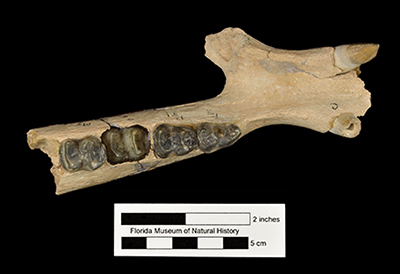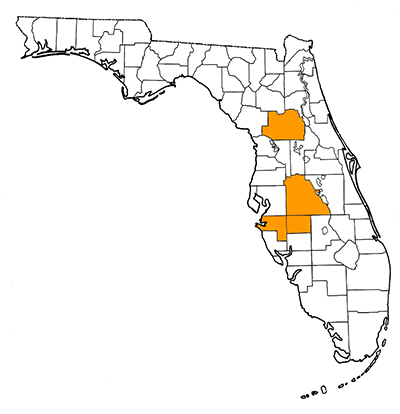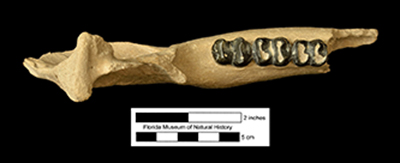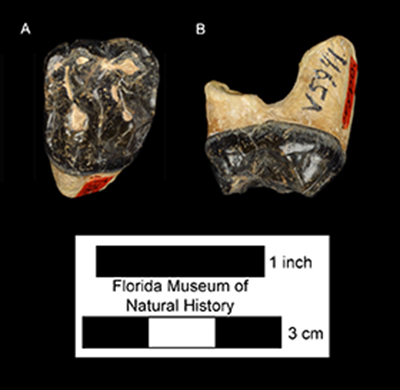Tapirus polkensis

Quick Facts
Common Name: Olsen’s dwarf tapir
This is the smallest known member of the genus Tapirus.
Other “dwarf” tapirs are known from Europe but are apparently not closely related to Tapirus polkenesis.
It is the most abundant mammal at the Gray Fossil Site in eastern Tennessee. There are more individual tapirs found here than at any other single fossil site.
Age Range
- Very late Miocene to early Pliocene Epochs; Hemphillian land mammal age
- About 7 to 4.5 million years ago
Scientific Name and Classification
Tapirus polkensis Olsen, 1960
Source of Species Name: After Polk County, Florida, where the type specimens originated
Classification: Mammalia, Eutheria, Laurasiatheria, Perissodactyla, Tapiromorpha, Tapiroidea, Tapiridae
Alternate Scientific Names: Tapiravus polkensis

Overall Geographic Range
In addition to central Florida, Tapirus polkensis is also known from a large sample from the Gray Fossil Site in eastern Tennessee (Hulbert et al., 2009).
Florida Fossil Occurrences
Florida fossil sites with Tapirus polkensis:
- Hardee County—Fort Green Mine South
- Manatee County—Fort Green Mine Southwest
- Marion County—Withlacoochee River; Withlacoochee River 5E
- Polk County—Palmetto Fauna (Achan Mine; District Grade Mine; Fort Green Mine; Fort Meade Mine; Kingsford Mine; Palmetto Mine; Silver City Mine; South Pierce Mine; Tiger Bay Mine; Whidden Creek Site, Fort Meade Mine)
Discussion

Tapirus polkensis is the smallest known species of Tapirus in either North or South America. It has an estimated average mass of 125 kg or 275 pounds (Hulbert et al., 2009). The species was originally described on the basis of one isolated upper premolar and two partial lower jaws from the Central Florida Phosphate Mining District (Bone Valley) in Polk County (Olsen, 1960). The geologic age of these specimens was not well established at the time, but specimens later recovered from in-place sediments with datable fossil species demonstrate that the species belongs to the early Pliocene Palmetto Fauna (Webb et al., 2008). The species was originally placed in the genus Tapiravus, a poorly defined early to middle Miocene genus of small-sized tapirs (Schoch, 1984). More complete material from Florida and Tennessee places it in the genus Tapirus (Hulbert et al., 2009).

Three species of fossil tapir are known to have come from the phosphate mines of Polk and adjacent counties in Florida: Tapirus polkensis and an undescribed medium-sized species of Tapirus from the early Pliocene Palmetto Fauna; and early Pleistocene specimens of Tapirus haysii. Contrary to Yarnell (1980), there are no known Miocene tapirs from the Bone Valley. Fossils of Tapirus polkensis and the undescribed species are about equally abundant in the Bone Valley mines. Teeth and foot bones of a small tapir matching the smaller Palmetto Fauna species were recovered with late Miocene (Hemphillian 2) species in the Withlacochee River 5E locality in Marion County (Hulbert, 2005). However no specimens of this small tapir were found at the more abundant Withlacoochee River sites 4A and 4X., which instead have a medium-sized species of Tapirus.
The skull of Tapirus polkensis is similar in many ways to those of younger North American species of tapir (e.g., Tapirus haysii, Tapirus veroensis). They all have a triangular interparietal bone, an infraorbital foramen located dorsal to the third premolar, a broad, flap-like posterior process on the lacrimal bone, and an extensive, deep depression on the frontal and nasal bones for the meatal diverticulum (Hulbert et al., 2009). However, the skull of Tapirus polkensis has a weaker or unformed sagittal crest, a shorter lacrimal bone, and a strongly slanted back of the skull dorsal to the foramen magnum. The upper molars frequently have a ridge (cingulum) on the back portion of the outer side of the tooth; this is a primitive feature not found in the Pleistocene species (Hulbert, 1995; 2005). Other than this, the teeth of Tapirus polkensis are basically smaller versions of those found in larger species in the genus Tapirus.
Sources
- Original Author: Richard C. Hulbert Jr.
- Original Completion Date: March 3, 2009
- Editors: Natali Valdes and Richard C. Hulbert Jr.
- Last Updated On: May 12, 2015
This material is based upon work supported by the National Science Foundation under Grant Number CSBR 1203222, Jonathan Bloch, Principal Investigator. Any opinions, findings, and conclusions or recommendations expressed in this material are those of the author(s) and do not necessarily reflect the views of the National Science Foundation.
Copyright © Florida Museum of Natural History, University of Florida